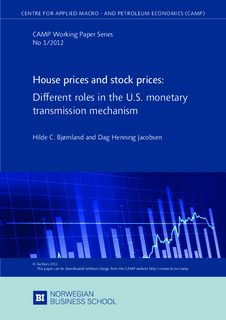| dc.description.abstract | We analyze the role of house and stock prices in the monetary policy transmission
mechanism in the U.S. using a structural VAR model. The VAR is identifed using a combination of short-run and long-run (neutrality) restrictions, allowing for contemporaneous
interaction between monetary policy and asset prices. By allowing the interest rate and
asset prices to react simultaneously to news, we find different roles for house and stock
prices in the monetary transmission mechanism. In particular, following a contractionary
monetary policy shock, stock prices fall immediately, while the response in house prices is
much more gradual. However, the fall in both house prices and stock prices enhances the
negative response in output and inflation that has traditionally been found in the literature.
Regarding the systematic response in monetary policy, stock prices play a more important
role in the interest rate setting in the short run than house prices. As a consequence, shocks
to house prices contribute more to GDP and inflation fluctuations than stock price shocks. | no_NO |
